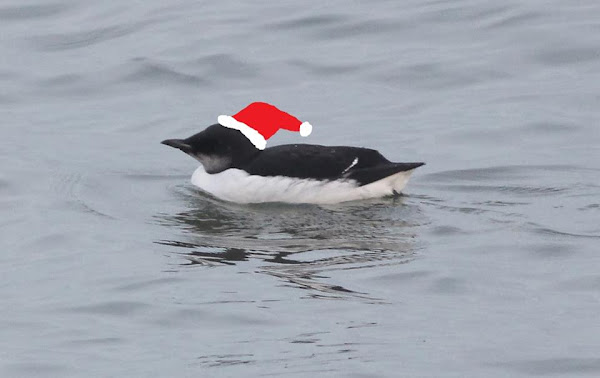As many birders (especially those with access to the east coast) will be more than aware, there's been an unprecedented number and/or claims of Brünnich's Guillemots from coastal watchpoints in recent days, almost all involving that most controversial of sightings, the seawatch fly-by; particularly controversial in this case, where historical fly-by claims of this species are still very much the subject of ongoing debate.
More rarity-focused readers will have seen the various photographs of 'Brünnich's Guillemots' - either claimed as definite, mooted as possible/probable, and/or seemingly judged as acceptable - online over recent days, too, which is why I thought this post might be of interest. I'm no expert, but having done a hell of lot of seawatching over the years here on the Yorkshire coast, I'm acutely aware of how many interesting (sometimes very interesting) fly-bys one has to let go - seawatching, more than any other birding discipline, isn't for the faint-hearted where potential rarities are concerned, being inately infused with the regular frustrations of probables, could-have-beens and likely-weres.
Arguably looking bigger, darker above, and showing more of a rugby ball profile than its companions
Again, overall the left-hand bird looks bigger, darker, and - subjectively - somewhat blunt-ended / stubby-billed. There's a limited amount of dark colouring on the otherwise pale underwing, which could easily be interpreted either way - a plainer underwing is a percieved feature of Brünnich's, and yet a cursory web search of them in flight reveals plenty with dark feathering and shadowing within this range.
With that in mind, I thought it might be worth posting about a bird I photographed last week here at Filey - on the day of the majority of Brünnich's claims, the 28th November. I was in the middle of a lengthy seawatch, with the species very much on my radar (following birds in the eastern North Sea, and then Norfolk, in preceding days), when a bulky, dark, stubby-looking auk rounded the Brigg, heading north with two winter plumage Common Guillemots - and so I grabbed the camera, found them in the viewfinder and fired off a series of shots, shown here (unedited but for cropping).
Still arguably looking big, and rotund, in comparison with its buds, and showing extensive white on the flank sides up onto the upperparts. But, is the bill looking a bit long and spiky? It could easily just be a photographic anomaly, however - but then, so could several other pro- features mentioned.... Not the greatest of views, but not the worst, either, particularly of a fly-by seabird, and I umm'ed and aah'ed over it throughout the watch; back home, I reviewed the photos on the big screen, and still felt uneasy enough to send them to various birding friends for their opinions. The replies were equally inconclusive overall, with some stating it looked good for Brünnich's, some thinking it was better for Common, and others on the fence.
The relevant features are, subjectively, addressed in the photo captions above and below, but the bird (and the photos) highlight various questions as to what constitutes an acceptable fly-by Brünnich's Guillemot, from this (or any) period: How many photos are required, at what level of quality and at what kind of distance? From how many angles? Should they involve comparable species?
There are other issues involved, too: how much of an advantage is it to have a (tough to ID, often brief, often in far-from-ideal conditions) seawatching fly-by like a putative Brünnich's multi-observed (as opposed to single-observed)? Some would say it's important; others, not so much, especially when factoring in the potential conformation bias of a communally exciting moment. And what about the even more loaded and fraught issue of non-photographed claims? How much emphasis is weighted towards the quality of the description, or the reputation of the observer(s), or the length / distance of the views?
A minefield at best, and a shitstorm at worst - who'd be on a rarities committee when all these claims come up for assessment....?! Note that I'm not doubting or judging any recent (or historical) claims or sightings, but just throwing this in the mix for reference.
Note also that I'm lucky enough to have already found a Brünnich's locally, in Filey Bay eight years ago - at the time, the first live record for mainland England (see here) - so there's zero envy agenda at play here....!
I'm sticking with you.....
Still big and dark, still notably pot-bellied, but what about the bill - or at least the (potentially misleading) photographic impression of it? Subjectively too 'pointy'? But, if the photo were of poorer quality, the bill would likely appear less defined, and therefore more Brünnich's-like. Insert shrugging emoji here (and after all the captions, for that matter)
Also worth pointing out - there were plenty of examples of darker, 'Northern' Common Guillemots on the move during the day and indeed week - lots of variation evident within that species







